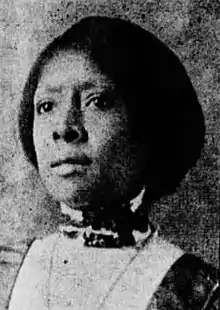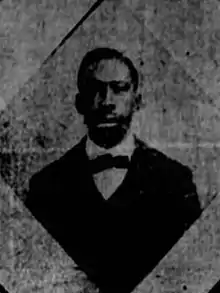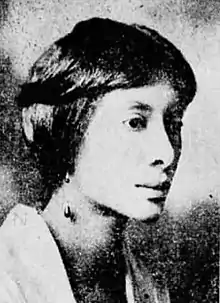Maude Brockway
Maude Brockway (February 28, 1876 – October 24, 1959) was an American teacher, milliner, and activist. She was born in Arkansas in 1876 and moved to Indian Territory after completing her education at Arkansas Baptist College. Initially, she worked as a teacher around Ardmore, Chickasaw Nation and then opened a hat-making business. In 1910, she moved to Oklahoma City and became involved in the Black Clubwomen's Movement. She was one of the founders of the state affiliate, Oklahoma Federation of Colored Women's Clubs and city chapter, Oklahoma City Federation of Colored Women's Clubs of the National Association of Colored Women's Clubs. She served as president of the city chapter from 1925 to 1950 and of the state federation from 1936 to 1940, as well as holding offices in the national organization.
Maude Brockway | |
|---|---|
 Brockway in 1922 | |
| Born | Mary Maude Sterling February 28, 1876 |
| Died | October 24, 1959 (aged 83) |
| Nationality | American |
| Other names | M. J. Brockway, Mary Maude Brockway, Maude Jane Brockway, Maude Sterling |
| Education | Arkansas Baptist College |
| Occupation(s) | teacher, milliner, activist |
| Years active | 1896–1959 |
| Children | 1 |
In addition to her work with the Federation, Brockway was involved in many church-affiliated organizations, serving in local and state positions. She founded the Oklahoma Training School for Women and Girls, in Sapulpa, Oklahoma, and Brockway Community Center in Oklahoma City. The center hosted well-baby clinics, training courses, a daycare center, and the second Black-owned private birth control clinic in the United States. In 2019, the center which bears her name was nominated for inclusion on the National Register of Historic Places, as a significant marker of black history in Oklahoma.
Early life
Mary Maude Sterling was born on February 28, 1876[1][2][3][Notes 1] in Clark County, Arkansas.[3][12] She grew up in Curtis and attended school at the Arkadelphia Presbyterian Academy, a primary and secondary school established to educate the children of former slaves.[12][13] She went on to further her education at Arkansas Baptist College.[12]
Career

By 1896, Sterling had married William Brockway and moved to Indian Territory. There they had a daughter, Inez, and Brockway taught[2] at schools in Ardmore and Berwyn in the Chickasaw Nation.[12] She joined the Baptist Young People's Union, and in 1906 was serving as its president.[14] That year, she began operating a milliner's shop in Ardmore.[15] Around 1910, the family moved to Oklahoma City, Oklahoma Territory, where Brockway continued to work as a milliner and her husband worked as a real estate agent.[5][16] Once in Oklahoma City, she became very active in the Black Clubwomen's Movement, which was focused on improving and protecting the lives of black citizens.[17]
In 1910, Brockway became one of the founders of the Oklahoma Federation of Negro Women's Clubs, which later changed its name to the Oklahoma Federation of Colored Women's Clubs (State Federation).[18] The group was an affiliate of the National Association of Colored Women's Clubs, founded by Mary Church Terrell,[19] and its first president was Harriet Price Jacobson, a teacher.[20][Notes 2] The following year, she became one of the founders of the Oklahoma City Chapter of the State Federation (City Chapter).[31] In 1917, Brockway founded, and from 1918 to 1919, served as the superintendent of the newly established Oklahoma Training School for Women and Girls, in Sapulpa, while maintaining her home in Oklahoma City.[32] This school was later known as the Drusilla Dunjee Houston Training School.[33]

In 1920, she returned to Oklahoma City, resuming her club work and helped the City Chapter to purchase their first headquarters, at 501 Northeast 4th Street.[6][34] Many of the various clubs Brockway was involved in were tied to her church work, in the Order of the Eastern Star; the Oklahoma Women's Baptist State Convention, becoming its president in 1918; and in the formation of the Oklahoma City Mission Society Federation, serving as its president in 1919.[35] As an organizer for the State Federation, Brockway assisted in the club in spreading statewide, serving in that capacity until 1921.[17][36] The following year, she became a second vice president of the state organization.[37] By 1925, she was elected president of the City Chapter, a post she would hold for 25 years.[17][4] In that capacity, she made a significant contribution to the chapter through her real estate management skills. She helped the organization sell its first headquarters and purchase a property at 615 Northeast 4th Street. Brockway bought adjoining lots for $15,000 and then transferred them to the federation for $1. The two-story dwelling became officially known as the Brockway Community Center.[34]
In 1935, Brockway was chair of the National Education Committee of the Women's Auxiliaries to the National Baptist Convention.[38] In 1936, she became president of the State Federation and served a four-year term.[12] She was instrumental in re-organizing the association into regions within the state and established the Princess Revue program to establish educational and philanthropic contributions to the NAACP.[26][39] In 1938, as part of the Maternal Health Organization of the State Federation and the City Chapter, she established the second Black-owned private birth control clinic in the United States. The clinic operated in the Brockway Community Center, was staffed by two physicians, and directed by Brockway.[40] In addition, she supervised a free health clinic for infants, a nursery, a training center for domestic sciences and a shelter for homeless youth at the center.[4] After her term as state president, she served as parliamentarian and statistician for the National Association of Colored Women's Clubs.[41]
Throughout the 1940s, Brockway lectured on uplifting black communities and continued her work with various church-affiliated organizations.[42][43] In 1947, she spent two months in Europe lecturing about programs for blacks for the Woman's Missionary Union and returned to talk about her trip to groups in the US.[16][44][45] Though Brockway did not support segregated schooling and campaigned against it,[46] when a new facility for Douglass High School, the first senior high school for black students in Oklahoma City, broke ground in 1953, she was among the dignitaries in attendance.[47][Notes 3]
Death and legacy
Brockway died on October 24, 1959, in Okmulgee, Oklahoma, while attending the state convention of the Women's Auxiliary of the state Baptist Convention.[3] Soon after making her address to the assembly, she had a heart attack and died.[4] Her funeral was held on November 5 at Calvary Baptist Church and she was buried in Trice Hill Cemetery in Oklahoma City.[3] The Oklahoma Federation of Colored Women's Clubs honored her with a memorial service during the 50th Anniversary celebrations of the organization's founding.[49] Brockway's daughter, Inez Brockway Brewer became an active clubwoman and teacher.[3][50] In 1968, the Brockway Community Center moved to 1440 North Everest Avenue and in 2019,[51] it was nominated for inclusion in the National Register of Historic Places listings in Oklahoma County, Oklahoma.[52] The center, named in Brockway's honor, is the only extant structure affiliated with the Black Clubwoman's Movement.[17]
Notes
- Sterling's name is often given as Maude Jane or Maude J.[4] Her birth year varies significantly, appearing as 1876,[2] 1877,[5] 1881,[6] 1882,[7] 1883,[8] 1885,[1] and circa 1900.[3] Her obituary also states that her father was Rev. Edward Sterling, but the only family living in Clark County, Arkansas between 1870 and 1880 with this surname were the children Queen A. (1864), King (1866), Martha (1867), Thomas (1868), Rosann (1870-before 1880), Miles (1871), Mary Jane (1873), Edwards (1875), twins Ella and Della (1877), Katie (1879), and Lilly (1880) of a farmer, William Sterling and his wife, Sarah Jane (née Jones).[9][10] In 1900 William and his wife, Mary, reported their granddaughter, Inez Brockway living with them.[11]
- Strong lists subsequent presidents of the State Federation as Judith C. Horton, 1915–1919;[21] Anna H. Cooper, 1919–1924;[22] Nellie Weaver Greene, 1924–1928;[23] Adelia E. Young, 1928–1932;[24] Lucy Elliott Hutton, 1932–1936;[25] Brockway, 1936–1940;[12] Lula E. Kiff, 1940–1944;[26] Genevieve M. Weaver, 1944–1948;[27] Mildred P. Williams, 1948–1952;[28] Ellen M. Roberson, 1952–1956;[29] and Jessie B. Hibler, 1956–[1960].[30]
- Though Strong indicates that Brockway was designated as the Woman of the Year in 1956,[12] this appears to be a confusion of sources, as newspapers confirm she bestowed the award of the State Federation's Woman of the Year to the 1956 honoree, Cernoria D. Johnson.[48]
References
Citations
- Ship Passenger Lists 1947.
- U.S. Census 1900a, p. 11A.
- The Black Dispatch 1959, p. 1.
- Maroon Society 2019.
- U.S. Census 1910, p. 32A.
- U.S. Census 1920, p. 13A.
- U.S. Census 1940, p. 1A.
- U.S. Census 1930, p. 10A.
- U.S. Census 1870, p. 58.
- U.S. Census 1880, p. 58.
- U.S. Census 1900b, p. 9A.
- Strong 1957, p. 93.
- Griffith 2013.
- The Baptist Rival 1906a, p. 4.
- The Baptist Rival 1906b, p. 1.
- Hines & Garrett 1949, p. 9.
- Montgomery & Pearce 2019, p. 14.
- Montgomery & Pearce 2019, pp. 14, 19.
- Montgomery & Pearce 2019, pp. 7–9.
- Strong 1957, p. 85.
- Strong 1957, p. 86.
- Strong 1957, p. 88.
- Strong 1957, p. 89.
- Strong 1957, p. 91.
- Strong 1957, p. 92.
- Strong 1957, p. 94.
- Strong 1957, p. 96.
- Strong 1957, p. 97.
- Strong 1957, p. 98.
- Strong 1957, p. 100.
- Montgomery & Pearce 2019, p. 19.
- The Black Dispatch 1917, p. 5; The Black Dispatch 1918a, p. 1; The Black Dispatch 1918b, p. 5; The Black Dispatch 1920, p. 4; The Black Dispatch 1921a, p. 5.
- Nevergold & Brooks-Bertram 2007, p. 23.
- Montgomery & Pearce 2019, p. 20.
- Strong 1957, p. 93; Montgomery & Pearce 2019, p. 14; Nevergold & Brooks-Bertram 2007, p. 23; The Black Dispatch 1919, p. 8.
- The Black Dispatch 1921b, p. 6.
- The Black Dispatch 1922, p. 2.
- Hailey 1935, p. 9.
- Strong 1960, p. 8.
- Rodrique 1991, p. 179.
- Strong 1957, p. 78.
- The Daily Oklahoman 1941, p. 11.
- The Oklahoma City Star 1942, p. B3.
- The Ponca City News 1947, p. 2.
- The Oklahoma County Register 1947, p. 4.
- The Daily Oklahoman 1949, p. 38.
- Moon 1978, pp. 252, 308.
- Labor's Daily 1956, p. 2.
- The Black Dispatch 1960, p. 7.
- The Black Dispatch 1922, p. 2.
- Montgomery & Pearce 2019, pp. 4–5.
- Montgomery & Pearce 2019, pp. 25–26.
Bibliography
- Griffith, Nancy Snell (July 18, 2013). "Arkadelphia Presbyterian Academy". Encyclopedia of Arkansas. Little Rock, Arkansas: Central Arkansas Library System. Archived from the original on 5 August 2020. Retrieved 15 October 2020.
- Hailey, R. W. (7 February 1935). "American Baptist Theological Seminary Receives Gift of a Beautiful Car". The Baptist and Reflector. Nashville, Tennessee. p. 9. Retrieved 16 October 2020 – via Newspapers.com.
- Hines, Louise; Garrett, Lula Jones (20 August 1949). "Daughters of Calanthe Do Work, Knights of Pythias, the Bossing". The Baltimore Afro-American. Baltimore, Maryland. p. 9. Retrieved 17 October 2020 – via Newspaperarchive.com.
- Montgomery, Catherine; Pearce, Matthew (December 3, 2019). "National Register of Historic Places Registration Form: Brockway Community Center" (PDF). OkHistory. Oklahoma City, Oklahoma: Oklahoma Historical Society. Archived (PDF) from the original on 15 October 2020. Retrieved 15 October 2020.
- Moon, Mary Carletta (1978). Frederick Douglass Moon: A Study of Black Education in Oklahoma (PDF) (PhD). Norman, Oklahoma: University of Oklahoma. Archived from the original (PDF) on 16 October 2020.
- Nevergold, Barbara A. Seals; Brooks-Bertram, Peggy (2007). Uncrowned Queens: African American Women Community Builders of Oklahoma. Vol. 4. Buffalo, New York: SUNY Press. ISBN 978-0-9722977-4-5.
- Rodrique, Jessie M. (1991). The Afro-American Community and the Birth Control Movement, 1918-1942 (PhD). Amherst, Massachusetts: University of Massachusetts Amherst.
- Strong, Willa (26 August 1960). "Oklahoma Federation of Colored Women's Clubs Convenes in Fiftieth Annual Session at Tulsa Church". The Black Dispatch. Oklahoma City, Oklahoma. p. 8. Retrieved 16 October 2020 – via Newspapers.com.
- Strong, Willa Allegra (1957). The Origin, Development, and Current Status of the Oklahoma Federation of Colored Women's Clubs (PDF) (PhD). Norman, Oklahoma: University of Oklahoma. Archived from the original (PDF) on 16 August 2016.
- "1870 U.S. Census, Caddo Township, Clark County, Arkansas". FamilySearch. Washington, D. C.: National Archives and Records Administration. 14 July 1870. p. 58. NARA publication M593, Roll #49, lines 2–8. Retrieved 14 October 2020.(subscription required)
- "1880 U.S. Census, Caddo Township, Clark County, Arkansas". FamilySearch. Washington, D. C.: National Archives and Records Administration. 29 June 1880. p. 57. NARA publication T9, Roll 40, lines 11–23. Retrieved 14 October 2020.(subscription required)
- "1900 U.S. Census, Ardmore, Chickasaw Nation, Indian Territory". FamilySearch. Washington, D. C.: National Archives and Records Administration. 8 June 1900. p. 11A. NARA publication T623, Roll 1848, lines 23–25. Retrieved 14 October 2020.(subscription required)
- "1900 U.S. Census, Caddo Township, Clark County, Arkansas". FamilySearch. Washington, D. C.: National Archives and Records Administration. 11 June 1900. p. 9A. NARA publication T623, Roll 53, lines 28–31. Retrieved 14 October 2020.(subscription required)
- "1910 U.S. Census, Oklahoma City, Oklahoma County, Oklahoma". FamilySearch. Washington, D. C.: National Archives and Records Administration. 27 April 1910. p. 32A-32B. NARA publication T624, Roll 1266, lines 49–51. Retrieved 14 October 2020.(subscription required)
- "1920 U.S. Census, Oklahoma City, Oklahoma County, Oklahoma". FamilySearch. Washington, D. C.: National Archives and Records Administration. 16 January 1920. p. 13A. NARA publication T625, Roll 1474, lines 29–31. Retrieved 14 October 2020.(subscription required)
- "1930 U.S. Census, Oklahoma City, Oklahoma County, Oklahoma". FamilySearch. Washington, D. C.: National Archives and Records Administration. 11 April 1930. p. 10A. NARA publication T626, Roll 1919, lines 4–8. Retrieved 14 October 2020.(subscription required)
- "1940 U.S. Census, Oklahoma City, Oklahoma County, Oklahoma". FamilySearch. Washington, D. C.: National Archives and Records Administration. 2 April 1940. p. 1A. NARA publication T627, Roll 3344, lines 1–5. Retrieved 14 October 2020.(subscription required)
- "At Atoka". The Baptist Rival. Ardmore: Indian Territory. 2 February 1906. p. 4. Retrieved 15 October 2020 – via Newspapers.com.
- "Baptist Women Hear Leader". The Daily Oklahoman. Oklahoma City, Oklahoma. 5 November 1941. p. 11. Retrieved 16 October 2020 – via Newspapers.com.
- "Club Women Launch Golden Anniversary". The Black Dispatch. Oklahoma City, Oklahoma. 11 March 1960. p. 7. Retrieved 16 October 2020 – via Newspapers.com.
- "Colored Women's Clubs Oppose Segregation". The Daily Oklahoman. Oklahoma City, Oklahoma. 16 March 1949. p. 38. Retrieved 16 October 2020 – via Newspapers.com.
- "Commencement!". The Black Dispatch. Oklahoma City, Oklahoma. 7 June 1918. p. 1. Retrieved 16 October 2020 – via Newspapers.com.
- "Echoes from the Calvary Baptist Church". The Black Dispatch. Oklahoma City, Oklahoma. 18 March 1921. p. 5. Retrieved 16 October 2020 – via Newspapers.com.
- "Hallelujah, 'Tis Done—Baptists of Oklahoma Triumph". The Black Dispatch. Oklahoma City, Oklahoma. 9 January 1920. p. 4. Retrieved 16 October 2020 – via Newspapers.com.
- "Mission Society Federated". The Black Dispatch. Oklahoma City, Oklahoma. 18 April 1919. p. 8. Retrieved 16 October 2020 – via Newspapers.com.
- "Mrs. C. D. Johnson Receives Honor as Woman of the Year". Labor's Daily. Oklahoma City, Oklahoma. 16 July 1956. p. 2. Retrieved 14 October 2020 – via Newspapers.com.
- "Mrs. M. J. Brockway Dies at Okmulgee Meet". The Black Dispatch. Oklahoma City, Oklahoma. 30 October 1959. p. 1. Retrieved 14 October 2020 – via Newspapers.com.
- "Negro Baptist Church to Hear Special Talk". The Ponca City News. Ponca City, Oklahoma. 10 October 1947. p. 2. Retrieved 16 October 2020 – via Newspapers.com.
- "News from Luther Colored Folks". The Oklahoma County Register. Luther, Oklahoma. 27 November 1947. p. 4. Retrieved 16 October 2020 – via Newspapers.com.
- "Oklahoma Federation of Colored Women's Club". Maroon Society. Oklahoma City, Oklahoma. February 12, 2019. Archived from the original on 17 October 2020. Retrieved 17 October 2020.
- "Oklahoma Training School for Women and Girls". The Black Dispatch. Oklahoma City, Oklahoma. 28 December 1917. p. 5. Retrieved 16 October 2020 – via Newspapers.com.
- "Oklahoma Training School for Women and Girls". The Black Dispatch. Oklahoma City, Oklahoma. 2 August 1918. p. 5. Retrieved 16 October 2020 – via Newspapers.com.
- "Our Women Join in Day of Prayer for State Missions". The Oklahoma City Star. Oklahoma City, Oklahoma. 11 September 1942. p. B3. Retrieved 16 October 2020 – via Newspapers.com.
- "Purcell Notes". The Black Dispatch. Oklahoma City, Oklahoma. 18 March 1921. p. 6. Retrieved 16 October 2020 – via Newspapers.com.
- "Ship Passenger Lists, New York City Arrivals". Ancestry.com. Washington, D. C.: National Archives and Records Administration. 30 August 1947. number P472, SS Sobieski, line 5. Retrieved 14 October 2020.(subscription required)
- "The Achievement and Progress of the Oklahoma Federation of Colored Women's Clubs". The Black Dispatch. Oklahoma City, Oklahoma. 24 August 1922. p. 2. Retrieved 16 October 2020 – via Newspapers.com.
- "(untitled)". The Baptist Rival. Ardmore: Indian Territory. 9 March 1906. p. 1. Retrieved 15 October 2020 – via Newspapers.com.